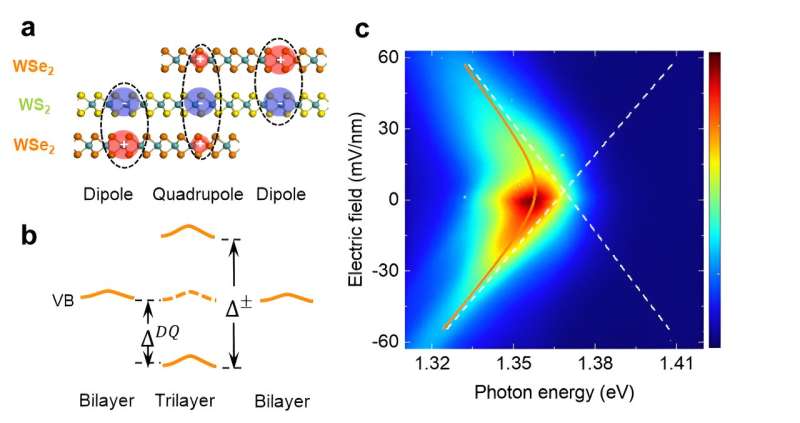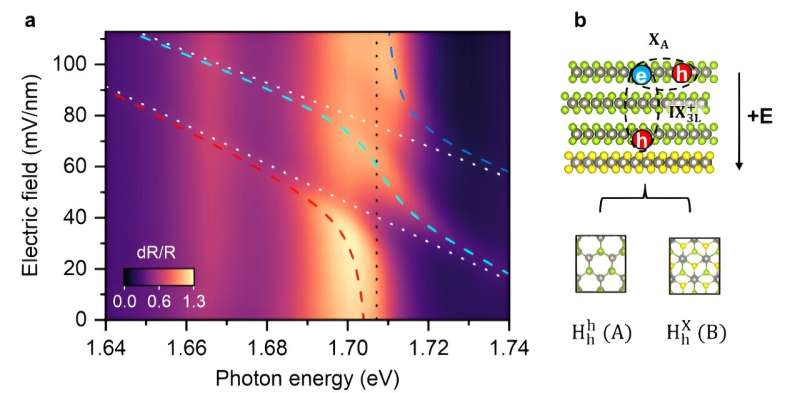September 28, 2023 feature
This article has been reviewed according to Science X's editorial process and policies. Editors have highlighted the following attributes while ensuring the content's credibility:
fact-checked
peer-reviewed publication
trusted source
proofread
Recent manipulations of excitons in moiré superlattices

Light can excite electron and hole pairs inside semiconducting materials. If the attraction between a negatively charged electron and a positively charged hole (the antiparticle of electron in solid state physics) is strong, they stay bound together, forming states known as excitons. In these states, positively charged holes can be viewed as the vacancies left behind by the electrons they are paired with.
Excitons contribute to shaping the optical properties of semiconductors. In recent years, they have been commonly exploited to create various solar energy harvesting technologies and light-emitting diodes (LEDs).
Researchers at Rensselaer Polytechnic Institute, University of California Riverside, and other institutes in the United States and Japan have conducted extensive research investigating excitons in moiré superlattices, materials comprised of two or more 2D materials arranged in a unique pattern. In two recent papers published in Nature Communications, they gathered new findings that could inform the development of quantum computers and other advanced technologies.
Their first paper unveiled a new type of exciton in moiré superlattices comprised of atomically thin semiconductors, dubbed quadrupolar exciton. This discovery could enable the development and application of new types of quantum matter, such as Bose-Einstein condensates.
"In atomically thin semiconductors, the attraction between electron and holes is enhanced, leading to extremely stable excitons that do not even get separated at room temperature," Sufei Shi, one of the lead researchers who carried out the study, told Phys.org. "Excitons in 2D materials thus have enhanced the absorption of light. In addition, the quantum properties of the excitons are also important. As a result, we can potentially utilize excitons for quantum computing and quantum simulations."
Moiré superlattices are essentially composed of two or more atomically thin crystals stacked on top of each other, with a twisted angle or so-called lattice mismatch. The structure arising from this arrangement gives rise to a longer periodicity, which is typically over 10 times larger than the original lattice.
Moiré superlattices have been the focus of numerous recent works, as they are promising platforms for the manipulation of excitons. For instance, they allow excitons to be trapped in specific positions, hence broadening their degrees of freedom.
"Transitional metal dichalcogenides (TMDC) are atomically thin semiconductors," Shi said. "TMDC heterobialyer, constructed from two different TMDC layers, can have moiré superlattice. This heterobilayer also hosts a special new exciton called the interlayer exciton, with the electron in one layer and the hole in the other. This interlayer exciton is long-lived and can be sensitively tuned through application of an electric field."
The interlayer excitons studied by Shi and his colleagues are strongly repulsed by one another and this strong repulsion could be leveraged to create new quantum states. In some instances, however, a lower repulsion is desirable.
As part of one of their recent papers, the researchers tried to tune the interaction between excitons in Moiré superlattices, specifically reducing the repulsion between excitons. To do this, they created a symmetric tri-layer moiré superlattice (i.e., WSe2/WS2/WSe2).
"One can think of this superlattice as one dipolar exciton added to another dipolar exciton with opposite polarization (electron-to-hole direction)," Shi said. "The superposition of these two dipolar excitons creates quadrupolar excitons, which possess much less repulsion between each other and new interactions among themselves. With enough density, these quadrupolar excitons can form theoretically predicted new quantum states as square lattices, a quantum phase transition dictated by the unique interaction among quadrupolar excitons."

The quadrupolar excitons demonstrated by the researchers could be used to realize specific quantum states of matter, including Bose-Einstein condensates. In their experiments, Shi and his colleagues also found that their superlattice could slow down electrons, prompting them to strongly interact with one another.
"This property was passed on to excitons as well, as an exciton consists of an electron and hole pair, and both are closely related to the electron (the hole is essentially the vacancy of the electron)," Shi said. "Previously we found that dipolar excitons interact with correlated electrons (electrons with strong interaction). In this work, we found that quadrupolar excitons also interact with correlated electrons."
Overall, this first study carried out by Shi and his colleagues could help to identify new insulating states, where holes jump back and forth between the first and third layers of their superlattice but are laterally confined, thus preventing electrical conduction. This new insulating state is of a quantum nature, as the sharing of holes between the superlattice's top and bottom layers occurs through a process known as quantum tunneling.
In a second paper, also published in Nature Communications, Shi and his colleagues further explored ways to manipulate excitons in moiré superlattices. Specifically, they were interested in the new functions that could arise from these manipulations.
"One route is to manipulate moiré excitons to realize the so-called superposition of moiré excitons, which is a new quantum state, in which the exciton is half at one site but half at the other—you cannot determine where they are, only the probability, which is the essence of quantum mechanics," Shi said. "If we can do that, that is also a new way for quantum computing with the moiré exciton as a qubit to construct a new quantum state."
To realize the superposition of moiré excitons, Shi and his colleagues had to overcome a key challenge. Specifically, as moiré excitons are trapped, they are typically confined at one particular site, and different species of moiré excitons are spatially separated.
"To tackle this challenge, we tried to find a 'common friend' to two moiré excitons," Shi explained. "Although the two moiré excitons cannot talk to each other directly, we make them talk to an intralayer exciton, where the electron and hole are in the same layer. Since the intralayer exciton is mobile and not be fixed at one position, they are more friendly and can talk to each moiré exciton easily."
To demonstrate their idea, the researchers constructed a moiré superlattice composed of three WSe2 layers and one WS2 layer. This structure draws inspiration from their previous work, where they outlined methods to manipulate moiré excitons through the layer degree of freedom.
"We know that the moiré excitons only exist at the interface of WSe2/WS2, and there are two types of moiré excitons depending on where they are trapped," Shi said. "Although direct communication (quantum tunneling) between these two moiré excitons is not possible, each of the moiré excitons can talk to the intralayer exciton in the third layer WSe2 (away from the interface) by tuning an out-of-plane electric field to match the energy between the moiré interlayer exciton and the free intralayer exciton."
In this second study, Shi and his colleagues were able to realize exciton superposition in their moiré superlattice. They did this by allowing moiré interlayer excitons to transition between different layers of the superlattice, connecting the two moiré excitons with each other.
"This unique tuning of moiré exciton is possible partially due to the unique band structure of trilayer WSe2," Shi added. "Similar to the case of quadrupolar excitons, the holes can be shared between the first and third layer WSe2, a unique feature due to the way how natural WSe2 (or TMDC in general) layers are stacked. By coupling this unique feature with the unique moiré interface between WSe2/WS2, we demonstrate the tuning of the moiré exciton hybridization through an electric field."
The recent works carried out by this team of researchers could soon have interesting implications for the development of quantum computers and simulation tools. The new superlattices introduced in their two studies could also be used to realize and study new quantum states.
More information: Zhen Lian et al, Exciton Superposition across Moiré States in a Semiconducting Moiré Superlattice, Nature Communications (2023). DOI: 10.1038/s41467-023-40783-z
Zhen Lian et al, Quadrupolar excitons and hybridized interlayer Mott insulator in a trilayer moiré superlattice, Nature Communications (2023). DOI: 10.1038/s41467-023-40288-9
Journal information: Nature Communications
© 2023 Science X Network



















